
The UK and Ireland’s bid to host Euro 2028 has been approved by UEFA’s executive committee after Turkey pulled out of the running.
Here, the PA news agency looks at the 10 stadia across five nations which will host the matches in just under five years’ time.
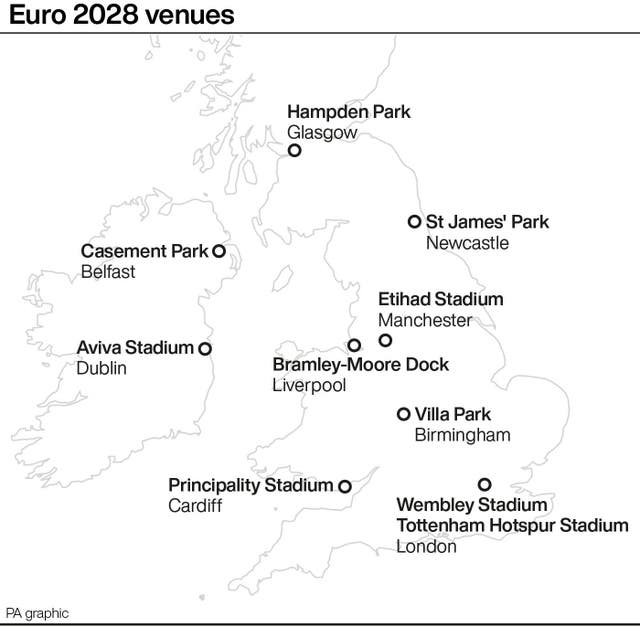 (PA graphic)
(PA graphic)
ENGLAND
Wembley
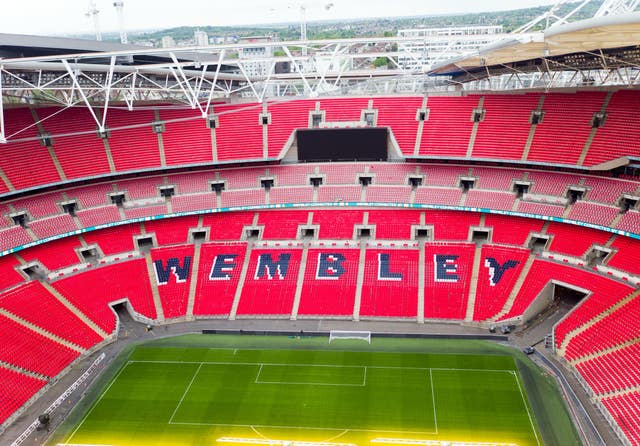 Wembley hosted both the Euro 96 and Euro 2020 finals (Steve Parsons/PA)
Wembley hosted both the Euro 96 and Euro 2020 finals (Steve Parsons/PA)
England’s national stadium will host the final – and potentially both semi-finals – having also been the venue for the Euro 96 finale and the decisive England v Italy clash at Euro 2020. The Football Association will be working hard with the authorities to ensure there is no repeat of the chaotic scenes which surrounded that match. Wembley is celebrating its centenary this year, with the original stadium opening in 1923 for the British Empire Exhibition.
Etihad Stadium
Work is set to begin later this year on increasing the capacity of treble-winning Manchester City’s ground to almost 62,000 by 2025. The club left their former home ground Maine Road and moved into the stadium in 2003. It was built to host the 2002 Commonwealth Games and hosted the 2008 UEFA Cup final, while England’s football and rugby union sides have both staged fixtures there.
Tottenham Hotspur Stadium
 The Tottenham Hotspur Stadium opened in April 2019 (Clive Rose/PA)
The Tottenham Hotspur Stadium opened in April 2019 (Clive Rose/PA)
Spurs’ home is the largest club stadium in London, with a capacity of over 62,000. Opened in April 2019, the stadium includes a retractable pitch with a synthetic NFL surface underneath. Its 17,500-seat, single-tier South Stand is the largest in the UK and features Europe’s longest bar – The Goal Line.
Everton Stadium
The Toffees’ new home at Bramley-Moore Dock is scheduled for completion late next year. Developers are working to a capacity of 52,888.
St James’ Park
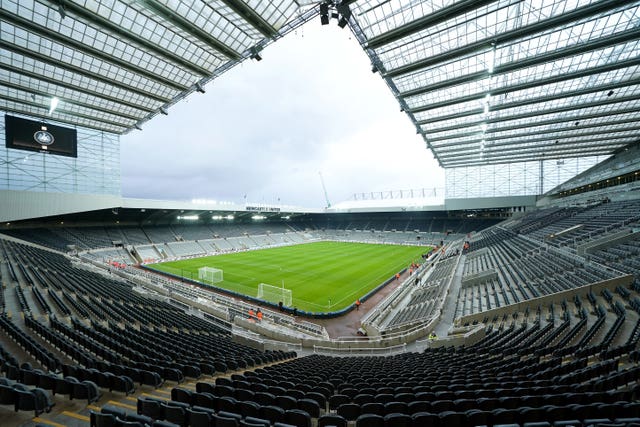 Newcastle are planning to extend the capacity of St James’ Park (Owen Humphreys/PA)
Newcastle are planning to extend the capacity of St James’ Park (Owen Humphreys/PA)
St James’ Park, home to Newcastle since the club was formed in 1892, also hosted matches at Euro 96. Newcastle are considering options to develop the stadium which might mean the capacity, currently 52,305, has increased by the time the championship begins in 2028.
Villa Park
Villa Park hosted three World Cup matches in 1966 and four matches during Euro 96. A go-to ground for FA Cup semi-finals – hosting 55 – the stadium is set to be redeveloped to increase capacity to over 50,000 ahead of the tournament.
REPUBLIC OF IRELAND
Aviva Stadium
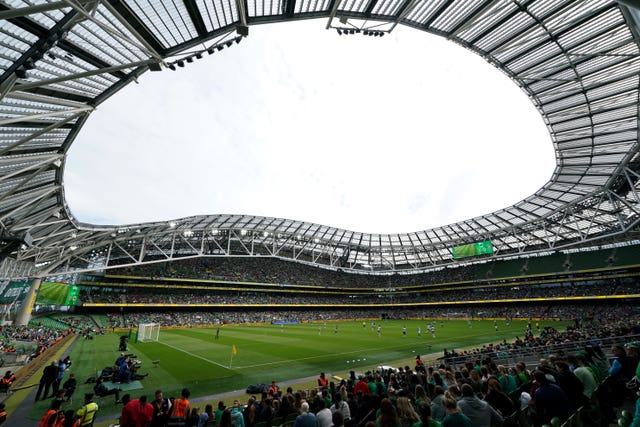 The Aviva Stadium was officially opened in 2010 (Brian Lawless/PA)
The Aviva Stadium was officially opened in 2010 (Brian Lawless/PA)
The Dublin venue, which holds over 51,000 people and officially opened in 2010, regularly hosts Republic of Ireland football matches and those of the Ireland rugby union team, as well as high-profile Gaelic sports. The stadium, built on the site of the former Lansdowne Road Stadium, which was demolished in 2007, had been part of the original multi-country plans to host Euro 2020 but could not ultimately provide UEFA with the necessary assurances over minimum spectator levels amid the Covid-19 pandemic.
NORTHERN IRELAND
Casement Park
Construction on the site in the Andersonstown area of Belfast is due to get under way next year with completion by 2026. The capacity of the stadium is set to be 34,500. It was opened in 1953 to stage Gaelic games and has since been home to the Antrim Gaelic Athletic Association.
SCOTLAND
Hampden Park
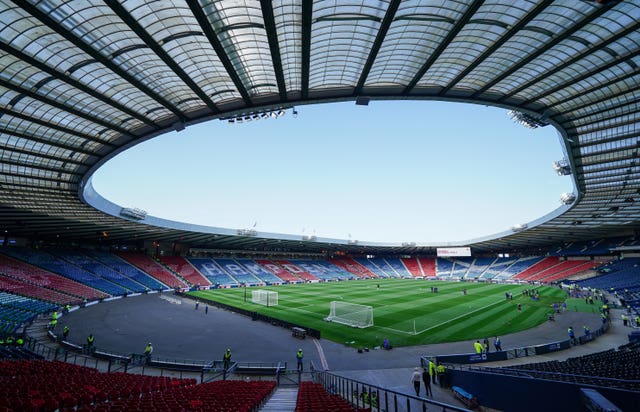 Hampden Park has been the home of Scottish football since 1903 (Jane Barlow/PA)
Hampden Park has been the home of Scottish football since 1903 (Jane Barlow/PA)
Scotland’s national stadium did host matches at Euro 2020. The Scottish Football Association has also bid to stage the Champions League final in 2026 or 2027 at the stadium, which currently holds just over 50,000. However, developers have put forward proposals to upgrade the stadium and increase capacity to 65,000. A record British crowd of 149,415 saw Scotland beat England 3-1 at Hampden in 1937.
WALES
Principality Stadium
The Cardiff venue has hosted major European football events before, having staged the 2017 Champions League final. Set to be the second-largest venue in the tournament with a capacity of 74,500.


Why are you making commenting on The Herald only available to subscribers?
It should have been a safe space for informed debate, somewhere for readers to discuss issues around the biggest stories of the day, but all too often the below the line comments on most websites have become bogged down by off-topic discussions and abuse.
heraldscotland.com is tackling this problem by allowing only subscribers to comment.
We are doing this to improve the experience for our loyal readers and we believe it will reduce the ability of trolls and troublemakers, who occasionally find their way onto our site, to abuse our journalists and readers. We also hope it will help the comments section fulfil its promise as a part of Scotland's conversation with itself.
We are lucky at The Herald. We are read by an informed, educated readership who can add their knowledge and insights to our stories.
That is invaluable.
We are making the subscriber-only change to support our valued readers, who tell us they don't want the site cluttered up with irrelevant comments, untruths and abuse.
In the past, the journalist’s job was to collect and distribute information to the audience. Technology means that readers can shape a discussion. We look forward to hearing from you on heraldscotland.com
Comments & Moderation
Readers’ comments: You are personally liable for the content of any comments you upload to this website, so please act responsibly. We do not pre-moderate or monitor readers’ comments appearing on our websites, but we do post-moderate in response to complaints we receive or otherwise when a potential problem comes to our attention. You can make a complaint by using the ‘report this post’ link . We may then apply our discretion under the user terms to amend or delete comments.
Post moderation is undertaken full-time 9am-6pm on weekdays, and on a part-time basis outwith those hours.
Read the rules here